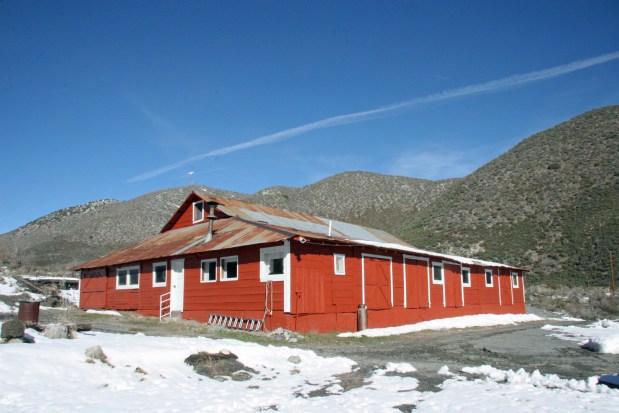Most of Southern California’s pioneer settlers chose to lay out their new farms in the region’s temperate plains and valleys, but a few brave souls ventured up into the San Bernardino and San Gabriel mountains to challenge Mother Nature and plant high-elevation apple orchards.
The earliest apple orchard in the Southern California mountains was planted in 1868, by Enoch Parrish in the Yucaipa area of the San Bernardino Mountains, that later became known as Oak Glen.
Joe Wilshire came to Oak Glen in 1877, and together with his industrious family members, he planted about 2,500 apple trees, ranging in elevation from about 4,500 to 5,100 feet.
Apple trees need lots of sun, good soil drainage, and a certain amount of “chill hours” to grow and thrive. Chill hours is the period of time per year that a fruit tree needs to be exposed to cooler temperatures, ranging from 32 to 45 degrees. Most apple varieties need 500 to 1,000 chill hours per year.

For reference, the famous Yakima Valley orchards in Washington are at about 1,350 foot elevation. Some apple orchards in Colorado operate at over 7,000 feet and apples are grown in the Himalaya Mountains of India at elevations over 11,000 feet High-elevation ranchers generally choose apple varieties with longer chill hour requirements, but even the most resilient strains can be damaged or destroyed by temperature extremes and late season frosts.
In the late 1800s and early 1900s, ranchers in the Wrightwood area of the San Gabriel Mountains began developing apple and fruit orchards at elevations ranging from about 4,900 feet to 6,200 feet. Remnants of Wrightwood’s three most famous orchards can still be seen today.
Lone Pine Canyon and Swarthout Valley are broad valleys with enough land for sizeable orchards, and the high valleys provide the cold temperatures needed to produce crops.
The Clyde Ranch was established around 1853, when Almon Clyde purchased property in upper Lone Pine Canyon from pioneer settler George Swarthout. After temporarily settling into a tent on the property, Almon and Priscilla Clyde and their nine children began developing their ranch into a successful farming and cattle ranching operation.
Around 1910, the Clydes started an apple orchard on 70 acres, along the canyon’s southern slope. Their orchard was laid out at an elevation of about 4,900 feet and featured Rome and Delicious apples.
The Clydes sold their apples directly from the ranch, and they also marketed their crops in the fruit exchanges in the San Bernardino Valley. The family built a large apple packing shed in the late 1910s or early 1920s to support their business. The quaint ranch house currently on the property was built sometime around 1940.
The Clyde family still owns the ranch, and occasionally sold apples from the packing shed until about 2014. In 2016, the Blue Cut fire raged up Lone Pine Canyon, and destroyed the packing shed and most of the orchard. The few remaining apple trees, along with the ranch house and old gas station building, can still be seen from Lone Pine Canyon Road.
In 1886, pioneer rancher Lionel Heath homesteaded property in the eastern end of the Swarthout Valley, about 3 miles northwest of Clyde Ranch, in present-day Wrightwood. The ranch drew its water supply from Sheep and Heath creeks, which passed through the property.
Heath’s Ranch started as a cattle ranching operation, but in the early 1900s, he planted an orchard of apples, pears, and cherries. The orchard was laid out in what is today’s Pacific Crest Estates section of Wrightwood at an elevation of about 5,800 feet.
Lionel Heath turned over operation of the ranch to his son Harry, and the family ranch house became a landmark in the east Swarthout Valley. Harry Heath sold the ranch in 1924. By the 1950s, the orchard had fallen into disuse, and the trees were no longer used commercially.
In 1890, Sumner B. Wright, namesake of Wrightwood, purchased 40 acres of land in Swarthout Valley from a miner known as McGuffey or “Guffey.” Guffey’s plot included a small stone house, and a small apple orchard, and an abundance of mature pine trees. Wright quickly began developing the property and expanding his holdings, and his ranch became the largest operation in the area.A section of the Heath’s apple orchard with fruit-bearing trees can still be seen in Wrightwood, at the corner of Chaumont and Pacific Crest drives.
Wright built a beautiful mountain home on present-day Mill Road in Wrightwood, and along with his wife Kate (Boone), the Wrights made their ranch into the economic and social centerpiece of the Swarthout Valley.
In 1910, Sumner turned over the ranch’s cattle operation to his nephew Buford Wright, and Kate’s nephew Bob Smith, so he could focus on his apple orchards. Eventually, Wright’s orchards stretched west from what is today’s Wrightwood Village to about Flume Canyon Drive. The elevation of Wright’s orchards ranged from about 6,000 feet to 6,200 feet, and weather conditions at this altitude were always a factor in the annual crop.
In the early 1920s, falling cattle prices, and several years of frost-damaged apple crops led Sumner Wright to subdivide and sell his ranch property. The resort community of Wrightwood was born. The first subdivision began in 1924, the orchards steadily were replaced by vacation homes.
A small intact section of Sumner Wright’s apple orchard can still be seen today at the southwest corner of Apple Avenue and Acorn Drive.

